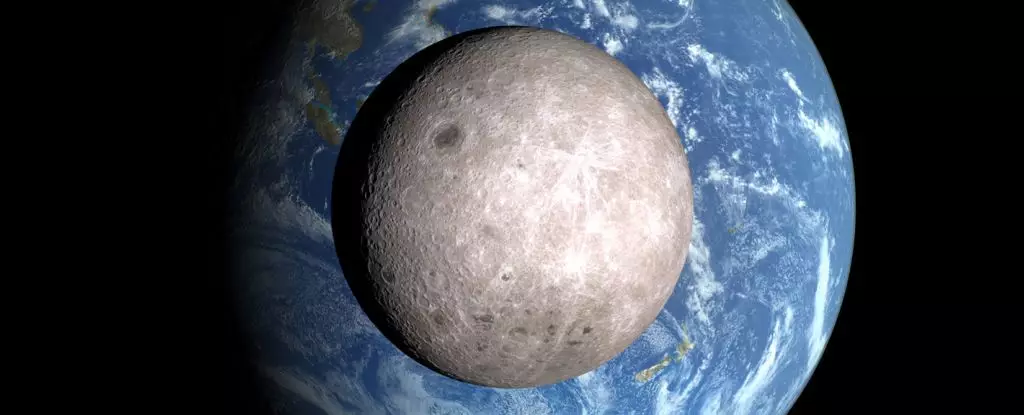The recent findings regarding water distribution on the Moon challenge our traditional understanding of celestial geology. The disappointing revelation that the far side of the Moon contains significantly less water than the side facing Earth raises questions about how our celestial companion formed and evolved. Once viewed as simply a rocky orb, scientific exploration is peeling back layers, exposing intriguing complexities that defy expectations. The implications of these water dynamics extend beyond the Moon itself, suggesting a myriad of untapped mysteries waiting to be unveiled in our solar system.
The differences between the two hemispheres prompt a re-examination of the Moon’s geological history, which could be described as nothing short of convoluted. The near side, an expansive field of basaltic maria formed from ancient volcanic eruptions, starkly contrasts the heavily cratered and rough landscape of the far side. This duality is not just a trivial detail—it’s a profound enigma that merits serious contemplation.
Giant Impacts and Lunar Formation Theories
Delving deeper, the events surrounding the Moon’s formation paint a chaotic canvas of colossal catastrophes. The prevailing theory suggests that a Mars-sized planetesimal named Theia collided with the early Earth, resulting in a cataclysm that birthed our Moon. Yet, this collision supposedly set the stage for uneven distribution of materials that we observe to this day. It’s frustratingly captivating that despite having a theory, we grapple with incongruities in data that leave us staring into the abyss of cosmic uncertainty.
Leading planetary physicists, such as Huicun He and Linxi Li from the Chinese Academy of Sciences, assert that studying the water abundance in lunar materials may shed light on these discrepancies. They argue that a clearer picture of lunar evolution hinges on understanding the asymmetrical distribution of water within the Moon’s mantle. However, this analysis is not without its pitfalls. While it anchors itself in existing knowledge, it requires an openness to new frameworks that might resist the conventional narrative crafted over decades.
A New Perspective on the Far Side
The analysis stemming from China’s Chang’e-6 mission, which successfully returned samples from the Moon’s far side, marks an exhilarating leap in lunar science. However, it is vital to recognize that these findings are merely the tip of the iceberg. A shocking 1 to 1.5 micrograms of water per gram of rock was found in the South Pole-Aitken Basin, a figure that aligns with expectations but also prompts a critical question: why are we accepting the data at face value without pushing for more profound inquiries?
Assertions that the lower water content could be a consequence of impact history necessitate a more nuanced interpretation. The nature of the Moon’s crystallization and volcanic history begs for a thorough reevaluation. Perhaps the far side’s dryness is a reflection of its tumultuous past, which not only incorporated cosmic collisions but also the long-term thermal dynamics influenced by Earth’s proximity.
In a world where water is often synonymous with life, the stark contrast in lunar hydration embodies a planetary dichotomy that is as perplexing as it is revealing. Why should we view our Moon as simply a companion when it holds such inexplicable depth? Discerning the differences between its hemispheres could open channels for understanding not just our Moon but other celestial bodies as well.
Implications for Future Research
One cannot help but feel an impending urgency that future explorations must grasp the complexities of these findings. The notion that the Moon may be drier than anticipated is merely one facet of a multifaceted enigma. Further investigations could unveil an array of geochemical anomalies waiting to be examined. If the far side does harbor more moisture, perhaps there exist geological reservoirs yet undiscovered. Each grain of lunar soil holds the potential for new insights that could revolutionize our celestial narratives.
The Moon, once relegated to mere poetic reflections in the night sky, is revealed to be a battleground of scientific inquiry. Undoubtedly, humanity’s journey to uncover its secrets is fraught with challenges; still, one must remain hopeful that the forthcoming data will guide us toward groundbreaking revelations. To decipher these celestial codes, we must adopt an investigative ethos that embraces both skepticism and a fervent curiosity—a delicate balance essential for transcending our current limitations in lunar science.


Leave a Reply